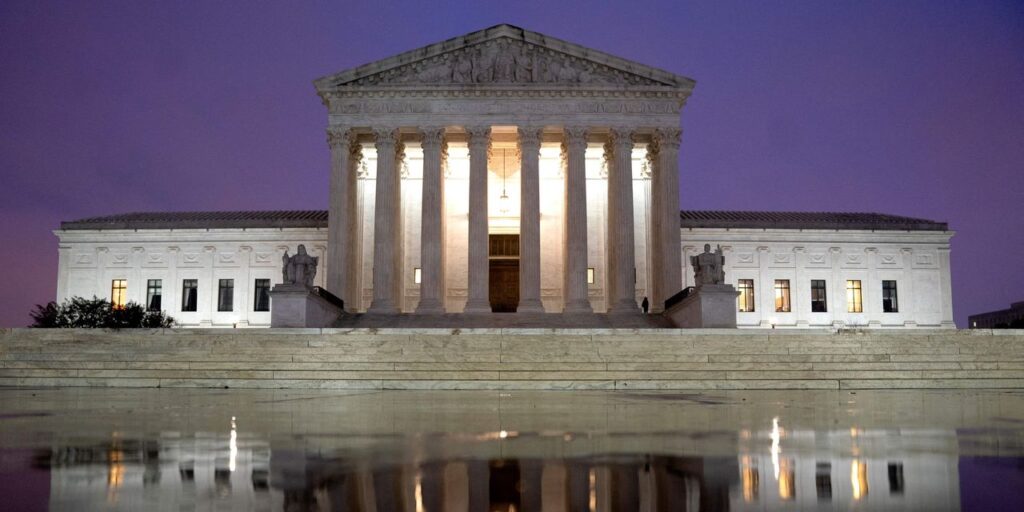The Supreme Court on Thursday limited the Environmental Protection Agency’s authority to police water pollution, ruling that the 50-year-old Clean Water Act should not allow the agency to regulate overflow into some wetlands near bodies of water.
The ruling comes down in favor of individual property rights over what previous officials had deemed beneficial to the public good in regulating natural waterways more extensively. This is the second major review of the EPA by this group of justices, whose conservative majority has already shown reluctance in broadening the reach for federal agencies.
With Thursday’s ruling, the court held that existing law covers only wetlands “with a continuous surface connection” to larger bodies of water that do fall under the EPA’s purview, Justice Samuel Alito Jr. wrote for the majority.
The ruling stems from the case brought by an Idaho couple who sought to build a house near Priest Lake in the state’s panhandle. Chantell and Michael Sackett objected when federal officials identified a soggy portion of the property as wetlands that required them to get a permit before building. There was no direct connection to a larger body of water on the Sacketts’ property.
Part of Thursday’s top court decision was conditionally unanimous, with all justices agreeing that the homeowners who brought the case should not have been subject to the agency’s oversight. But there was a divide over the scope of the ruling.
Conservative justice Brett Kavanaugh, joined by the three liberal justices in a concurring opinion, said the decision would harm the EPA’s ability to combat pollution.
“The court’s new test will leave some long-regulated adjacent wetlands no longer covered by the Clean Water Act, with significant repercussions for water quality and flood control throughout the United States,” Kavanaugh wrote.
In fact, with Thursday’s vote, the court jettisoned the 17-year-old opinion by their former colleague, Anthony Kennedy, which had allowed regulation of wetlands that have a “significant nexus” to the larger waterways.
“Wetlands are critical habitats for fish, waterfowl and other wildlife. And they shield communities from the destructive power of floods and storms,” said Earth Justice, a nonprofit organization of environmental lawyers, in a release. The group estimated as many as 118 million acres of formerly protected wetlands now fall under lighter regulation after the Sackett ruling.
“The court’s decision today aims to take our country backwards. It will jeopardize the sources of clean and drinking water for farmers and millions of Americans,” White House press secretary Karine Jean-Pierre said. She said White House lawyers are reviewing the ruling and their options, stressing that the president plans to use “every legal authority available to him to ensure Americans in every state have clean water.”
Last summer, the top court handed President Joe Biden’s broader climate-change agenda a setback when it ruled to restrict federal reach in controlling emissions at power plants and beyond.
In that case, justices were weighing the EPA’s authority to regulate greenhouse gas emissions from existing coal- and gas-fired
NG00,
power plants under the 50-year-old Clean Air Act, the sister legislation to the Nixon-era Clean Water Act.
In that 6-3 ruling, the court sided with mostly conservative, energy-producing states and fossil-fuel companies in adopting a narrower reading of the Clean Air Act. The decision prevents the EPA from enforcing climate-friendly, industrywide changes, limiting it to actions targeting individual plants.
Liberal justice Elena Kagan, writing Thursday in a second concurring opinion, tied the two cases together. “The majority’s non-textualism barred the EPA from addressing climate change by curbing power plant emissions in the most effective way,” she wrote.
With the latest ruling, the court “prevents the EPA from keeping our country’s waters clean by regulating adjacent wetlands. The vice in both instances is the same: the court’s appointment of itself as the national decision maker on environmental policy,” Kagan added.
To mark the Clean Water Act’s 50th year in 2022, a new report revealed how much the health of the U.S. natural water system remains concerning to scientists and others.
The Environmental Integrity Project (EIP), a nonpartisan nonprofit formed by former EPA attorneys published the 50-state review that found more than 700,000 miles of waterways, about 51% of assessed river and stream miles, are impaired by pollution. That’s in addition to another 55% of lake acres and 26% of estuary miles.
The report defined “impaired” as waters that are too polluted to meet standards for swimming and recreation, aquatic life, fish consumption or as drinking water sources.
The Associated Press contributed.
Read the full article here











